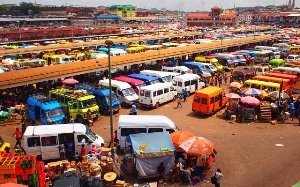 The Marine Drive project is expected to improve tourism in the Ghana
The Marine Drive project is expected to improve tourism in the Ghana
Undoubtedly, the Marine Drive Project represents Ghana’s most ambitious tourism product initiative since independence. It is therefore not surprising to learn that this particular project has been on the drawing board since the country’s early days. The commitment of the Minister of Tourism, Arts and Culture, Madam Catherine Afeku and her deputy, Dr Ziblim Iddi under the leadership of the President, Nana Addo Dankwa Akufo-Addo is duly acknowledged.
The government’s vision in positioning Ghana as a preferred leisure destination in the West African sub-region through this project is therefore commendable. Also worthy of commendation are the efforts of the erstwhile NDC government in commencing the project.
Such audacious projects naturally generate a lot of excitement from all perspectives. For government, this project is likely to have multifaceted benefits: creation of jobs (both direct and indirect) in the short and long term; stimulation of economic activity through the multiplier effects on other related businesses (hotels, restaurants, attractions); creation of forward and backward linkages with other economic sectors (e.g. agriculture for the supply of foodstuffs, and ancillary services such as banks etc.); improvement of the country’s forex position; and, the enhancement of Ghana’s image as a leisure destination as well as improvement in Ghana’s trade balances (due to potential increase in inbound tourism) are some of the foreseeable benefits associated with this project.
But, the Marine Drive is not the first big tourism investment in Ghana. About 25 years earlier, the Natural Resource Conservation and Heritage Protection Project (NRCHP) had been launched and implemented in Cape Coast- Elmina conurbation. Like the Marine Drive the NRCHP was essentially created as a mechanism through which the Central Region would harness its touristic potential to stimulate economic growth.
Under this project, the country’s three iconic attractions: the Kakum National Park, Cape Coast Castle and Elmina Castle were transformed and established as tourist attractions. While these creations resulted in the increased touristic patronage of the region (that is, Cape Coast and Elmina), there is very little to show for it economically or even, more broadly, developmentally. Simply put, the NRCHP was only partially successful in creating iconic attractions for Ghana, but failed to engender tourism-induced development as anticipated.
An ongoing study by the Department of Hospitality and Tourism Management of the University of Cape Coast has unearthed some reasons for the NRCHP’s limited impact. These included but not limited to:
unavailability of plans and structures to manage the tourism development process;
the local community was hardly engaged beyond mere tokenistic endeavours;
absence of a policy framework/ manual to guide the development and growth of tourism at the local level;
non-integration of the tourist trade into the local economy thereby being unable to create the needed linkages to stimulate growth in other economic activities;
absence of capacity building initiatives for members of the host community; and
weak public sector institutional leadership
Lessons for The Marine Drive
While it is refreshing to note that government’s commitment to invest US$1.2 billion into such a project bodes positively in enhancing the country’s product diversity. It is important to note that such a colossal investment can eventually be rendered ineffective without the proper supporting policy framework and legal infrastructure.
While tourism is mostly touted for positively impacting the lives of residents, it equally has the potential to negatively impact the lives of residents especially when there is large scale tourism development as intended in the Marine Drive Project. Negative externalities such as the disruption of local lifestyles, shifts in labour distribution, deepening the poverty situation of the locals (through localised inflation due to the presence of wealthy leisure tourists), and increased vulnerabilities of residents are some of the sticky points that stand out.
As in the case of the Marine Drive Project, there is the potential of the investors being largely multinationals and thus much of the highly skilled jobs may be filled by expatriates. In a dual consequence, while the multinational corporations repatriate their profits, their highly skilled employees will remit their wages to their home countries. Further, leisure tourists especially wealthy ones from the West are noted to crave their ‘environmental bubble’ when on holiday and hence may have little or no appetite for local cuisines and beverages.
Indeed, such tourist mostly has little or no contact with any sought with local residents. Consequently, the tourism enclave that may be created through the Marine Drive Project may have little or no integration with the local economy and may be characterised by leakages.
The first thing to do (if it hasn’t been done already) is to develop a comprehensive policy and plan for tourism activity in the area. This document should address important details such as the purpose of tourism development, indicators for monitoring tourism growth, strategies for ensuring local integration and community benefits.
Secondly, there must be conscious efforts to build local economic capacities. The ability of local residents to recognise the opportunities that accompany such project and be able to tap into it is hinged on such capacities. Entrepreneurial training, as well as training on hospitality and tourism service provisions, will help ensure that local people will constitute part of the highly skilled labour that will be employed in the tourism enclave. The product must be enriched by consciously integrating cultural products into the facilities and services that will be provided within such enclave. A blend of leisure and culture can uniquely define the Marine Drive Project and help minimise leakages.
Finally, there is the need to ensure local community participation in the planning and implementation of the project. Community participation at this stage should move beyond placation (merely giving out information) to real citizen participation (citizens actively participate in top decision making and implementation).
Such an initiative will first and foremost secure buy-ins of the local people and therefore help cultivate a sense of ownership among them. This community goodwill may help curtail potential conflict between local residents and managers of the project on one hand and local residents and tourists on the other and thus help guarantee the sustainability of the project.
Authored by:
Dr Issahaku Adam
(Senior Lecturer)
Department of Hospitality and Tourism Management
University of Cape Coast
Email: Issahaku.adam@ucc.edu.gh
- Performance Tracker: Beatrice Annan exposes government for listing Dodowa Hospital as part of Akufo-Addo’s achievement
- What exactly is your grand plan? - Franklin Cudjoe asks Akufo-Addo over sacking of SSNIT, GRA bosses
- Ghana is doing well, don't negate what we have achieved because NPP is in office – Nana Ofori-Atta
- Meet the 8 'prominent' lawyers Akufo-Addo has penciled to be justices of the Court of Appeal
- 58% of voters in the Ashanti Region say Ghana is heading in the wrong direction – Poll
- Read all related articles












